ICYMI, Congestion pricing is back
To finally address the whiplash that is the plan for congestion pricing, I turned to Tribecan and transportation consultant Charlie Komanoff, who by all counts is a proponent of congestion pricing — so if you are not, stop here! (I’ve also included some of my favorite neighborhood traffic photos.)
But first, the plan: the governor announced on Nov. 14 that she would restart the original program, but would reduce the toll to $9 initially, raising it in phases over the next six years to $15. The MTA board approved the plan on Nov. 18. It will start in the early morning hours of Sunday, Jan. 5.
Passenger vehicles will be charged $9 a max of once per day, and would get a discount of 75 percent outside the peak hours of 5a to 9p on weekdays and 9a to 9p on weekends.
Per-ride fees for all trips to, from or within the central business district south of 60th Street would be $0.75 for taxis and black cars and $1.50 for app-based for-hire vehicles.
So, to the analysis.
“The $9-$12-$15 toll trajectory in the congestion pricing program that Gov. Hochul exhumed last week won’t be as immediately effective as the straight $15 toll plan she scuttled in June,” Charlie wrote. “Nevertheless, it will accomplish a great deal in terms of cutting Manhattan and region-wide traffic and financing better transit (which in turn will trigger further cuts in traffic).
“Indeed, the ramp-up ($9 in Jan 2025 going to $12 in Jan 2028 and then to $15 in Jan 2031) has a certain elegance. Had it been proposed it a year ago, rather than the straight $15, it might have staved off some of the opposition that led to the governor’s June 5 political cave-in.
“My modeling indicates that the $9 toll will bring about an average 5 to 6 percent improvement in vehicle travel speeds in the congestion zone (Manhattan south of 60th Street). That’s not particularly impressive, but the speed boost will rise over time from the combination of the toll ramp-up and the completion of transit improvement projects — most notably the accelerated replacement of 90-year-old analog subway track signals with digital signals allowing closer spacing of trains — that will be bonded with the congestion revenues.
“By 2031, when the toll hits $15 and most or all of the transit improvements are in place, the average gain in Manhattan travel speeds will reach 15 to 16 percent, nearly triple the immediate, first-stage gain we can expect in January.”
NB: These speed figures aren’t the MTA’s — they are Charlie’s. “They’re generated by the congestion pricing spreadsheet model I’ve curated for nearly two decades, an earlier version of which was used by New York officials to craft the 2019 legislation that now authorizes the MTA to toll vehicles driven into the Manhattan core.”
You can run the model yourself in Excel here.
I know neighbors here have been frustrated by the fact that residents of the central business district were not carved out of the tolling plan, as they were in other cities. But I like to remind myself, especially when I walk up Hudson on a Friday afternoon, that we have the most to gain.
“I anticipate an immediate 13 to 14 percent reduction in traffic volumes on the three Brooklyn-to-Manhattan bridges that feed directly into the Lower East Side and Chinatown and the Civic Center,” Charlie said. “By 2031, this ‘attrition’ will reach a whopping 35 percent on weekdays and 25 percent on weekends.







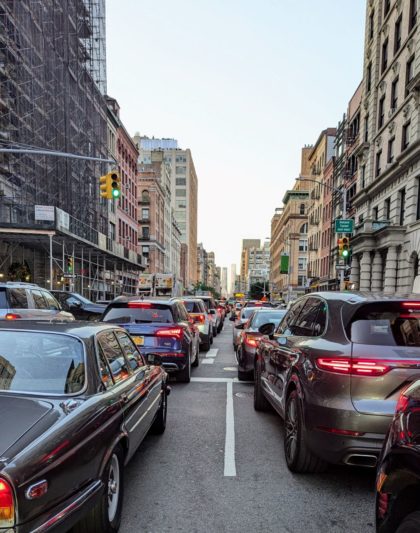
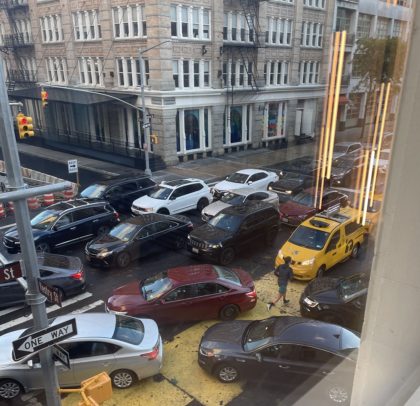
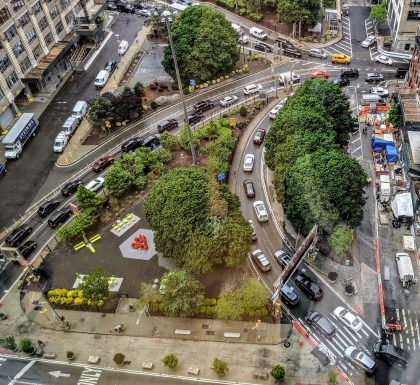
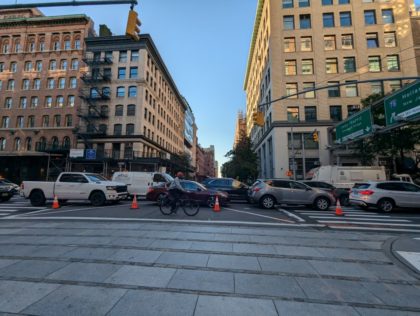
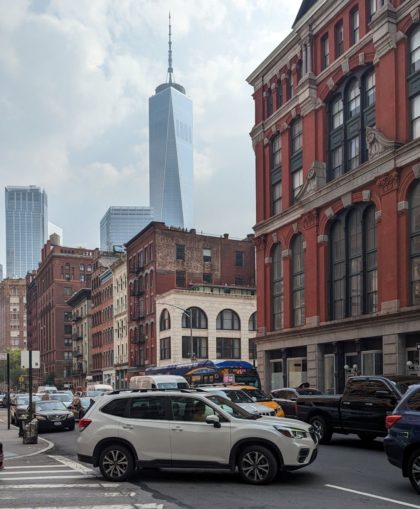






I certainly hope it will help. I’m all for giving it a try.
So along with this we really need enforcement of traffic regulations, including keeping crosswalks and intersections clear (Remember “Don’t Block the Box”). Plus bonus: Enforce the no honking laws. Imagine how many tickets (income, city!) that would generate.
Canal Street is one of the worst areas for scoff-law insane traffic, with no regard for pedestrian safety. Nearly got run over again on Canal Street the other day, because so many vehicles were in the crosswalk that turning vehicles couldn’t see (or didn’t care about) pedestrians who had the light. Recently we were a large group crossing Canal Street (we had the walk signal) and were nearly hit by someone who ran a red light. We all had to quickly get out of the way and it was a near miss. Driver was going way above speed limit as well…and just kept going, of course. If all else fails, let’s Canal Street back into a canal and have our own (undoubtedly filthy) Venice in New York.
Is there a good reason for traffic cops at an intersection? They are either redundant, repeating the commands of the traffic lights, or confusing, contradicting the commands of the traffic lights. It seems to me that any cops should be there for the sole purpose of enforcing the rules – including the aforementioned rules about red-light running, blocking intersections and crosswalks, and yes, horn-honking etc. But all of that could also be done with cameras and sound sensors (did those ever happen?). I never see cops giving tickets for these infractions.
YES to enforcement! It would likely be as effective as the toll in improving traffic and raising revenue for mass transit. Fare evasion, double parking, blocking intersections, running red lights. No one respects the rules when they are not enforced and this breakdown sadly pervades the city. It has to start somewhere!
they need to get rid of all those bike lanes to reduce traffic. also residents who live in the congestion zone should not be tolled to go home. they are not going below 60th street for luxury.
WHEN WILL THE TAXES STOP?????
Not a tax, but a toll. Like at the bridges and tunnels. This is for CBD.
This is not a tax, it’s a toll. You can tell because you can easily get out of paying it. I go into the zone almost every single day and yet I will never pay the toll. I’ll simply walk, take the subway, bike, or take a bus.
With the new administration. Along with Medicare, Social Security, the FDA, the Education Department…. you will enjoy plowing snow yourself, and treating illnesses with over-the-counter herbal medicine.
Regarding enforcement, the MTA / NYPD needs a plan to tackle fare evasion. Earlier this week I boarded a 34th St crosstown bus near NYU hospital, using the middle entrance of an articulated bus and a woman was leaning on and blocking the screen of the OMNY kiosk. I had to ask her to move so I could tap to pay my fare and she looked at me like I was crazy. Maybe I was, because of the 12 people who crowded on behind me, only one other person paid the fare. It was about the same ratio all the way west to 7th Ave, where I got off. In the pre-OMNY days when you had to get the little slip of paper before boarding there were often police officers at the 7th Ave stop asking to see them.
Also, can anyone explain to me why if I cross the Hudson eastbound on the GWB and then travel south to Tribeca on the WSH / 12th Ave / West St I won’t get a credit against the congestion fee, but if I travel south in NJ to either the Lincoln or Holland tunnels and then continue my trip on the same route I will? It doesn’t seem like a particularly hard programming problem given that my EZ-pass is going to trigger every toll.
Hooray! Hochul played truly awful politics with this, because she’s really not very good at her job, but in the end, her hands were tied, and that’s a good thing. I am loath to give her any credit for this, but whatever, we’re moving on.
I only worry that the $9 toll isn’t high enough to reduce congestion enough for people to see the immediate benefits, and the capital construction to improve the subways will take time. If/when they sell the bonds, though, there’s likely no going back regardless.
It’s also sort of infuriating that the price is lower than mass transit of various types. The peak toll of $9 and the off-peak toll of $2.25 are both still cheaper than an off-peak LIRR ride to Nassau ($10.75) and the subway fare ($2.90, likely $3 flat soon), each just for one person. It’s just perverse. But I’ll take any progress we can get.
totally agree, Hochul has watered down CP after illegally delaying implementation by six months & played terrible politics. She ran on enthusiastically getting it done! Hope she gets primaried by someone more effective
Regarding fare evasion on the subways, it might help to turn on the alarms again for the emergency gates. In the past, those emergency gates triggered the alarm, and was much less common to see people using it as an exit, much less holding it open so others could cheat their way in. The gates are clearly marked that they are for emergency use only, yet people now use them as an exit instead of exiting through the turnstiles.
Of course, there still has to be enforcement through ticketing. But at least the alarm is annoying, and if there are police around, that should alert them to address the fact that the gate is open and ticket all the cheaters using it.
How do other cities deal with fare evasion, especially on buses, if they use an electronic ticketing system (like OMNY) that has no physical printed receipt?
Still need clarification on one point…If I drive from…say, Greenwich Street and Chambers across the West Side Highway into BPC and then back out, does that trigger a charge?
It does not. See this post.
https://tribecacitizen.com/2023/08/14/clarity-finally-on-one-angle-of-congestion-pricing-for-downtown-residents/
Couple of things:
1 – Law Enforcement. I agree with all the above comments recommending that before you even get to congestion charging simply enforce the current law. Follow the traffic lights, don’t block the junctions, no use of the horn etc etc. For some reason New Yorkers seem to accept not following the law. Post de-fund the police seems to of created a city where no one expects the law to be enforced. Not the citizens, not the police. Why are people here cheering on this tax but not demanding law enforcement.
2 – It’s a tax. Taxing local residents and having it run to 9pm makes it a tax, In other cities they price it to actually hit peak congestion and wave it in off peak to encourage and support local businesses like restaurants. And they support local residents. Why is this being charged until 9pm and not 6.30pm and why all weekend ? , It’s fine to do that be just don’t call it a congestion charge call it a New York City Road Tax, acknowledge that local businesses will be hit.
3 – Exemptions. Will huge number of city employees parking exceptions also be excluded from paying the new tax ? As discussed here it’s difficult for local residents to park as city employees all have an exception to parking restrictions. If they are seems unlikely to make much change locally.
Of course it’s a tax and that was always the point, never mind the shiny wrapping of virtue they used to sell the idea — the law’s included metric is a $ amount raised, not a metric related to congestion, like the time it takes to drive across town or ambulance response times.
I recently saw an interview with an official that was involved in establishing London’s initial congestion fee and she admitted that while congestion dropped initially, it is now worse than before, which she attributed to the many traffic lanes they’d subsequently taken out of service for bike lanes, etc.
@N: Perhaps you missed a key nuance from the London rep. Yes, automobile travel speeds in the London zone are no better than they were prior to CP. No, congestion isn’t nearly as bad. How can those two statements be true? Because the number of private autos in the zone is down by half compared to pre-CP. As a result, the time that private motorists waste in traffic jams is down by half. Bus speeds are higher due to bus-only lanes. Bicycle speeds are higher due to bike-only lanes. (Yes, CP’s “space dividend” has gone to buses and bikes.) The number of *people* coming into London’s congestion zone each day is up 20-25% (vs. pre-CP) with no diminution in car speeds. That’s a triumph of CP, not a failiure. Details here: https://nyc.streetsblog.org/2023/02/06/latest-data-shows-again-that-londons-congestion-pricing-is-working
@Will:
2. I’m in sympathy w/ your opposition to the breadth of the peak price. Under the plan, 60% of all hours in the year, accounting for 80% of vehicle trips, will be charged the peak rate. That’s far too much. I proposed a peak/shoulder/offpeak plan in mid-2023 (https://www.komanoff.net/cars_II/NYC-15-9-3.pdf) that at least would have softened/feathered the peak. The MTA wasn’t interested.
3. The congestion pricing plan scheduled to start on Jan. 5 includes no exemptions for municipal employees’ private cars.
1. Lax (non-existent, actually) enforcement of traffic laws has been part of the city landscape for generations, though I agree it’s even worse now b/c drivers are so much more brazen. In my opinion, the absence of enforcement is not an argument against congestion pricing. If anything, CP might make enforcement easier by diminishing overall traffic chaos.
@Komanoff
Thank you for the thoughtful reply, very helpful On 1, I only moved here in 2007 and back then felt that enforcement was higher. I cycle round the city and was impressed that cylists got stopped if if they hopped on the sidewalk or went the wrong way down a one way street. Now it feels like a total free for all for cars and cyclists. not fact based just survey of one. On 2. that’s a shame, we and locally businesses need people coming into the city in off peak hours. Glad you formally flagged it, sorry it was ignored. Helps clarify the purpose of the tax. 3 good to know. Thanks again
That’s my impression as well. In the 2000s there was more adherence to the traffic rules.
Also, there is data the road rage has increased significantly since pre-pandemic.
It will not help but more flow into those people’s pockets. if you support this you are NAIVE
Charlie — What do your models say about congestion reduction coming in/out of the Holland Tunnel? That’s the worst in the neighborhood.
@person:
For the two NJ tunnels, inbound: only a 1.2% reduction immediately ($9, transit improvements still TK), rising to 4% once the toll has reached $15 and the bonded transit improvements have kicked in.
My model isn’t set up to calculate outbound. I imagine those reductions will be greater than the above percentages on account of fewer Bklyn to SI/Jersey trips traversing lower Manhattan, once the E River bridges are tolled.
Remember folks, YOU voted these people into power. All the issues this city faces and continues to face are a result of the poor leadership and focus on social reform rather than fixing the true issues EVERYONE faces (crime, infrastructure, sanitation). Maybe that will change how you all vote going forward, rather than just pandering to nonsensical social justice that hurts everyone.
I would say that it’s criminal to not exempt residents but sadly it does not surprise me because it’s ok to be a criminal here these days.
Worse than a tax – at least taxes give the illusion that the proceeds will actually be used for something – this is more wealth redistribution. Exactly the same as many of the parking meters in the neighborhood that have been changed to 10:00 p.m. while parking meters in many “opporunity zones” in the city have outright been removed. When building energy efficient rating fines begin they’ll almost certainly be targeted.
The MTA is broke because the Bragg’s of the world said it’s ok to hop turnstiles and enter buses through the back door. Pay your taxes, buy a car and want to drive out of the city to go on a hike on the weekend? – cough up $9
Where are the meters that go to 10p?
West broadway both sides in front of Edwards and Odeon. These were changed recently with no warning and I’m so used to parking there from time to time that I hadn’t realized it until I saw the ticket the next day. I’d imagine more will be changing. 9:00 p.m. is certainly not business hours so there’s no correlation to congestion or traffic patterns, it’s simply a revenue grab.
Are there any exemptions for the ill and handicapped driving to doctors?
The Individual Disability Exemption Plan (IDEP) is available for individuals who have disabilities or health conditions that prevent them from using transit. IDEP can be applied to a vehicle registered to the applicant, or to a vehicle registered to a person the applicant designates, such as a family member or a caregiver, if they use that vehicle to drive the applicant in the Congestion Relief Zone.
I believe this a a regressive tax especially when the law requires the MTA raise 1 billion per year from these tolls. Also probably half can be raised from stopping fare beaters.
@Matt:
Questions for you:
* Why does the $1b/yr revenue requirement make CP regressive?
* If it is regressive, why is Community Service Society, NYC’s venerable and most valorized anti-poverty organization, an outspoken supporter?
* What makes you think stopping fare beaters would bring in $500m a year? Aren’t most fare beaters bus riders who would stop riding buses?
* How can the putative revenue from stopping fare beating be used to bond NYCT capital investment?
* If stopping fare beating is a worthy objective — and I agree w/ you that it is — why not pursue it in addition to CP?
@Komanoff glad you agree about stopping fare beaters the MTA has admitted publicly to over 350 million being lost each year should be easy to find i am sure it is much more. Why regressive because it is a flat tax lower-income groups to pay a greater proportion of their income than higher-income groups pay. Also why would we want to bond 15 billion to the MTA that has been atrocious with managing money the waste will be unbearable hope it doesn’t happen but it will this is a cash grab instead the MTA should fix itself. And imagine if we had a safe subway system the revenue would go up tremendously in the evening as most people avoid the subway for this reason.
@Matt:
You didn’t answer my Q as to why NYC’s most venerable and respected antipoverty would org strongly support CP if it were economically regressive. (The answer of course is that it’s not: car trips into the zone are so heavily toward the wealthy, and lower-income NY’er s are so subway-reliant, that just about any policy that charges cars driven into the zone and spends the revenues on transit improvements is bound to be progressive.
Whether it’s $500m (your original figure) or $350m (your newer), you badly overstate farebeating-enforcement’s net revenue gain, IMO. Most stolen bus rides and many stolen subway rides would disappear if they couldn’t be done for free.
Your “unbearable waste” argument is IMO mostly a canard wrapped around a germ of fact. Most of the $12b in bonded subway improvements will be spent to accelerate the uptake of CBTC. Installing it (Communications-Based Train Control) on the L and 7 lines cost ~$60 million per track mile (in 2024$). I agree that it should have be cheaper, but even at that price going forward the gains in subway service — being able to run 20% more trains per hour — will save millions of hours for subway riders and, at least as importantly, help draw riders back to the trains, helping set in motion once more the virtuous cycle of more riders –> safer trains –> more riders that the transit system enjoyed from the mid-1990s to the mid-2010s.
Matt, it’s easy to bash big bureaucracies. I’ve done it myself. Respectfully, I think your anti-MTA, anti-CP negativity is largely out-of-date and out-of touch. Let’s stick to facts? Speaking of which, please try to answer my Q about the CSS and congestion pricing. Thanks.
@Komanoff:
Hope you had a nice Thanksgiving. By definition i still believe it’s a regressive tax the funds can be raised differently i due appreciate your response. I do not know why Community Service Society is pro CP however we can go back and forth all day long about organizations that are for or against CP. To name one that is against CP is Memorial Sloan Kettering a very respected organization as well. Also we all know if this was put to vote by NYC and NYS residents it would be an overwhelming NO why it was done after the election. FYI, i did not change my number on fare evasion the MTA believes the number is are 350 million i believe it is 500 million can you blame me look at the latest MTA waste of money headline “Cash-strapped MTA spent $250M on emergency subway intercom system that’s overrun with pranksters”
I see more small businesses struggling with CP and less people coming in the evening and weekends which is sad hopefully i am wrong but my gut feeling from talking to people about CP is over time businesses will relocate as well as workers nurses, civil workers, staff in the hospitality business that work late nights and i could go on and on about different professions are planning to basically avoid the CP zone due to the expense.
https://nypost.com/2024/11/26/opinion/mtas-252m-emergency-intercom-flop-is-another-insult-to-taxpayers/
The last thing the incompetent MTA needs is to be given more money. A private oversight board of business executives needs to be appointed to reform the agency and gut the waste, excessive spending, and fare beating.
This will hurt our businesses in the city. Restaurants, grocery stores etc. Working people will pay the price. All prices will go up because of congestion pricing. Cars need to pay for the MTA, please this will not be good.
Mr. Komanoff,
If I may….
It was my impression that bicycling is your transit mode – not subway or bus?
Perhaps I am mistaken but I believe in the past you have opined that it was fine to force bus detours for Open Streets, that it was ok to prioritize Open Streets over essential bus transit.
Is that accurate?
It is also worth mentioning that the MTA has been cutting bus frequency and bus routes for years – and CP will not result in more bus service.
As for bus speed, buses still need to stop at red lights and adhere to the speed limit.
IMO a slightly faster bus does not help if there are no buses and buses are packed.
CP won’t help bus riders (many of whom are elderly and have mobility difficulties.
@Jam:
” … a slightly faster bus does not help …”
Please don’t cherry-pick. The initial 5-6 percent gain I project in below-60th St driving speeds is a worst case. It’ll reach 10-11 percent in 2028 and 15-16 percent in 2031. If you believe this won’t be a boon for bus riders — and, by the way, attract more passengers — then I see no point in communicating further. Pls let me hear back, thanks. And this time, without ad hominem innuendos, please.
As a bus rider, the continuing reductions in bus service over the years are very upsetting and harmful
It appears these reductions will continue based on the MTA “redesign” plans.
Examples:
There are many times when there is no traffic and yet there are waits of 20 minutes or more for a bus.
The MTA split the M5 into two segments the M5 and M55 which means a transfer and adds at least 15 more minutes to the ride.
The MTA has been removing bus stops – for example there is no longer an M34 bus stop at Lexington Ave (going west).
Many elected officials don’t take buses.
It is really upsetting and unfair that they offer opinions and make decisions having no idea what it is like.
@Matt (replying to your Nov 29):
I brought up CSS b/c you contend CP is regressive. If it were, CSS would be the first to call it out. Their mission is empowering and uplifting NYC’s lower-income households. (Their web homepage says in big letters, “Powering a more equitable New York.”) Memorial Sloan-Kettering, a beloved/admired medical research & care organization, has no stake or expertise in economic equity and uplift. Your lack of interest in reading the CSS report belies your claim to care about CP’s regressivity or progressivity.
Fare evasion is a problem but it isn’t credible to posit that combatting it can replace CP as a revenue source (let alone reduce the oppressive volume of cars in and en route to the congestion zone).
I appreciate your collegiablity (btw, I did have a lovely Thanksgiving and hope you did too). Please try to consider that off-the-cuff opinions aren’t a substitute for hard analysis and, dare I say, expertise. Thanks.
Any idea if they changed how the program works? Or is it the same as previously discussed, except the amount of the tax escalates over the next couple of years?
The tolls are lower to start and will increase over time